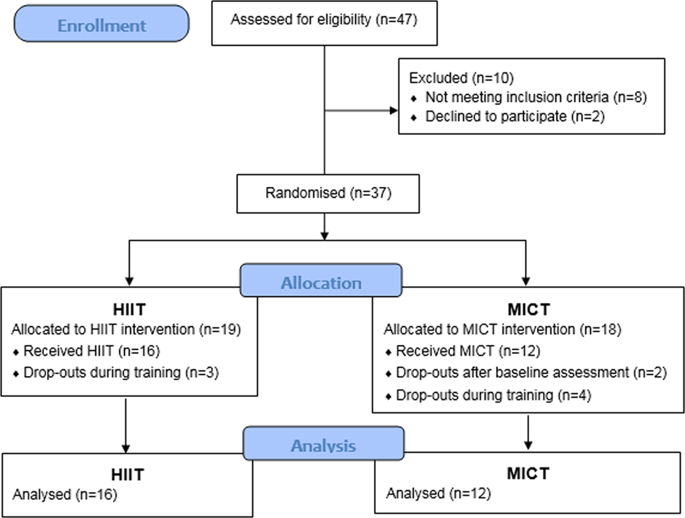Hypertension Research ( IF 5.4 ) Pub Date : 2020-01-14 , DOI: 10.1038/s41440-019-0392-6 Tomasin Clark 1 , Rob Morey 1 , Matthew D Jones 1, 2, 3 , Lauren Marcos 1 , Michael Ristov 1 , Adrian Ram 1 , Stefan Hakansson 1, 4 , Aysha Franklin 1 , Chris McCarthy 1 , Leal De Carli 1 , Rachel Ward 1 , Andrew Keech 1

|
The optimal exercise-training characteristics for reducing blood pressure (BP) are unclear. We investigated the effects of 6-weeks of high-intensity interval training (HIIT) or moderate-intensity continuous training (MICT) on BP and aortic stiffness in males with overweight or obesity. Twenty-eight participants (18–45 years; BMI: 25–35 kg/m2) performed stationary cycling three times per week for 6 weeks. Participants were randomly allocated (unblinded) to work-matched HIIT (N = 16; 10 × 1-min intervals at 90–100% peak workload) or MICT (N = 12; 30 min at 65–75% peak heart rate). Central (aortic) and peripheral (brachial) BP and aortic stiffness was assessed before and after training. There were no significant group × time interactions for any BP measure (all p > 0.21). HIIT induced moderate reductions in central (systolic/diastolic ∆: −4.6/−3.5 mmHg, effect size d = −0.51/−0.40) and peripheral BP (−5.2/−4 mmHg, d = −0.45/−0.47). MICT induced moderate reductions in diastolic BP only (peripheral: −3.4 mmHg, d = −0.57; central: −3 mmHg, d = −0.50). The magnitude of improvement in BP was strongly negatively correlated with baseline BP (r = −0.66 to −0.78), with stronger correlations observed for HIIT (r = −0.73 to −0.88) compared with MICT (r = −0.43 to −0.61). HIIT was effective for reducing BP (~3–5 mmHg) in the overweight to obese cohort. Exercise training induced positive changes in central (aortic) BP. The BP-lowering effects of exercise training are more prominent in those with higher baseline BP, with stronger correlation in HIIT than MICT.
中文翻译:

用于降低血压的高强度间歇训练:针对超重或肥胖男性的随机试验与中等强度连续训练
降低血压 (BP) 的最佳运动训练特征尚不清楚。我们调查了 6 周的高强度间歇训练 (HIIT) 或中等强度连续训练 (MICT) 对超重或肥胖男性血压和主动脉僵硬度的影响。28 名参与者(18-45 岁;BMI:25-35 kg/m 2)每周进行 3 次固定自行车,持续 6 周。参与者被随机分配(非盲)到工作匹配的 HIIT(N = 16;10 × 1 分钟间隔,90-100% 峰值工作量)或 MICT(N = 12;30 分钟,65-75% 峰值心率)。在训练前后评估中央(主动脉)和外周(肱)血压和主动脉僵硬度。任何 BP 测量都没有显着的组 × 时间相互作用(所有p > 0.21)。HIIT 诱导中枢 血压(收缩压/舒张压 Δ:-4.6/-3.5 mmHg,效应大小d = -0.51/-0.40)和外周血压(-5.2/-4 mmHg,d = -0.45/-0.47)适度降低。MICT 仅诱导舒张压中度降低(外周:-3.4 mmHg,d = -0.57;中央:-3 mmHg,d = -0.50)。BP 改善幅度与基线 BP ( r = -0.66 至 -0.78)呈强烈负相关,HIIT ( r = -0.73 至 -0.88) 与 MICT ( r = -0.43 至 -0.61)。HIIT 可有效降低超重至肥胖人群的血压(~3-5 mmHg)。运动训练引起中枢(主动脉)血压的积极变化。运动训练的降压效果在基线血压较高的人群中更为显着,与 MICT 相比,HIIT 的相关性更强。


























 京公网安备 11010802027423号
京公网安备 11010802027423号